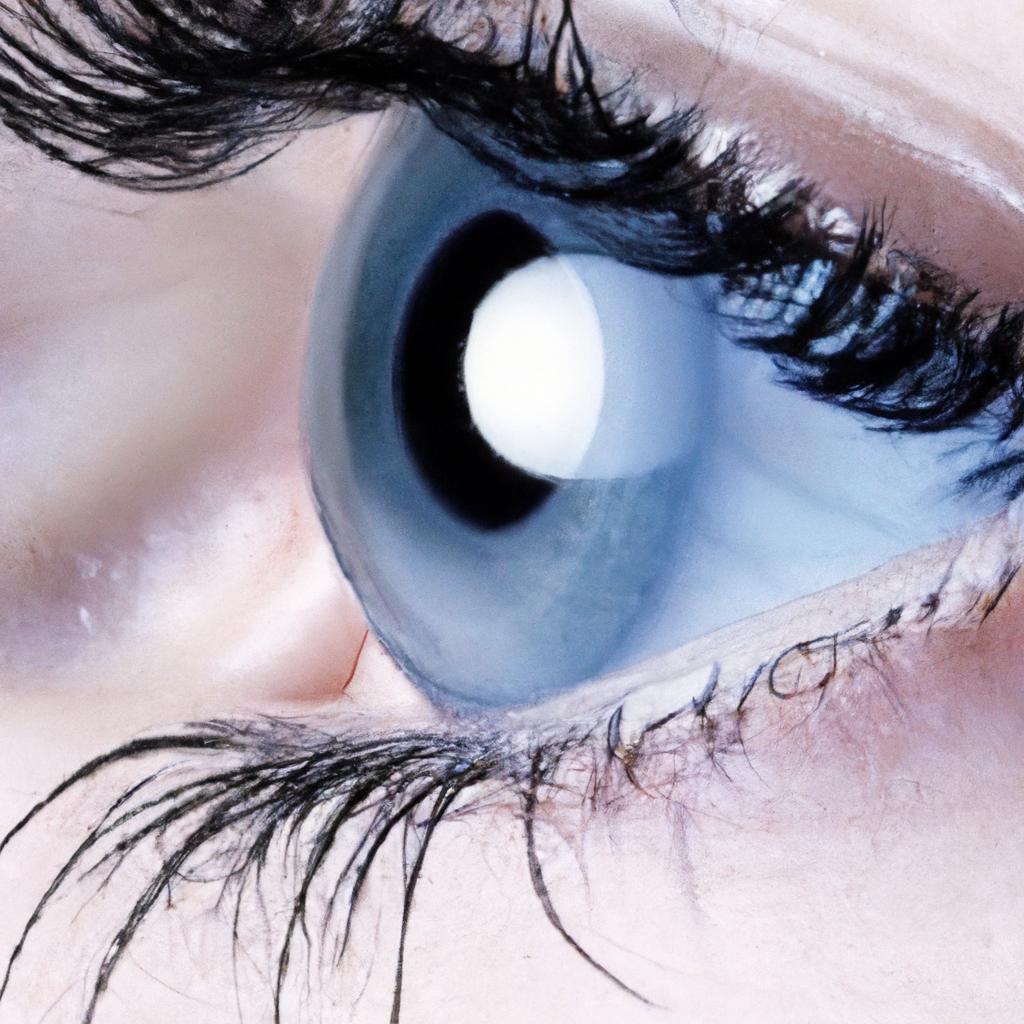Imagine being able to see things that were once beyond your reach. With the latest advancements in telescopic contact lenses, this is now a reality. These revolutionary lenses have the power to enhance your vision and provide a glimpse into a whole new world. Gone are the days of relying solely on glasses or traditional contact lenses to correct your vision. Step into the future and discover how telescopic contact lenses can transform your perception and open up a whole new realm of possibilities.

Understanding Telescopic Contact Lenses
Concept and working principle of telescopic lenses
Telescopic contact lenses are a type of innovative eyewear that utilize advanced optics to enhance vision beyond normal capabilities. These lenses incorporate miniature telescopes into the design, allowing wearers to see objects that would normally be too far away or too small to discern. The working principle of these lenses involves utilizing multiple lenses arranged in a specific manner to magnify the incoming light and provide a clearer image to the wearer.
How they enhance vision
Telescopic contact lenses enhance vision by magnifying the incoming light and focusing it onto the retina, thereby compensating for any refractive errors or visual impairments. By mimicking the functioning of a telescope, these lenses effectively increase the size of objects and improve visual acuity. This enhanced vision enables wearers to see distant objects with greater clarity and can greatly improve the quality of life for individuals with certain visual impairments.
Basic structure and design of telescopic contact lenses
Telescopic contact lenses typically consist of several layers, including a central telescopic lens, a corrective lens, and a protective layer. The central telescopic lens is responsible for magnifying the incoming light, while the corrective lens corrects any refractive errors specific to the wearer. The protective layer helps keep the lenses clean and free from debris. These lenses are designed to be lightweight, comfortable, and compatible with the natural curvature of the eye for optimal vision improvement.
Historical Background of Telescopic Contact Lenses
Early stages of development
The concept of telescopic contact lenses can be traced back to the early 1990s when researchers began exploring ways to incorporate miniaturized telescopes into wearable eyewear. Initial prototypes were bulky and had limited functionality, but they paved the way for further advancements in the field. These early stages of development laid the foundation for the future creation of telescopic contact lenses.
Breakthroughs and advancements
Significant breakthroughs in telescopic contact lens technology occurred in the early 2000s, with researchers successfully developing smaller, more lightweight lenses that were suitable for everyday use. These advancements allowed for greater comfort and improved vision enhancement. Alongside technological advancements, improvements in manufacturing techniques and materials also played a vital role in the evolution of telescopic contact lenses.
From glasses to contact lenses
Telescopic contact lenses represent a major leap forward in vision correction technology, bridging the gap between traditional glasses and conventional contact lenses. While glasses provide external magnification, they can be cumbersome and limit peripheral vision. On the other hand, traditional contact lenses correct refractive errors, but do not offer additional magnification. Telescopic contact lenses combine the benefits of both approaches to provide enhanced vision in a convenient and unobtrusive manner.
Emerging Tech in Telescopic Contact Lenses
Incorporation of nanotechnology
One of the recent advancements in telescopic contact lenses is the incorporation of nanotechnology. Nanotechnology allows for the creation of ultra-thin layers and precise optical structures, enabling the production of more compact and comfortable lenses. The use of nanomaterials also enhances the durability and longevity of the lenses while maintaining their optical performance.
Role of biomedical engineering
Biomedical engineering plays a crucial role in the development of telescopic contact lenses. By leveraging expertise in optics, materials science, and human physiology, biomedical engineers are able to design lenses that deliver optimal visual performance. Their interdisciplinary approach ensures that the lenses are safe, effective, and compatible with the human eye.
Automatic focus adjustment features
Advancements in automatic focus adjustment features are transforming telescopic contact lens technology. Some lenses now have the ability to automatically adjust the focus based on the wearer’s gaze, allowing for seamless transitions between near and far objects. This innovation enhances the usability and convenience of the lenses, further improving the overall user experience.
Comparison with Traditional Eyewear
Comparing effectiveness with regular contact lenses and glasses
Telescopic contact lenses offer distinct advantages over traditional eyewear options such as regular contact lenses and glasses. While traditional contact lenses correct refractive errors, telescopic contact lenses go a step further by providing magnification capabilities. Glasses, on the other hand, can be uncomfortable and restrict peripheral vision. Telescopic contact lenses combine the corrective abilities of contact lenses with the additional benefit of magnification, providing wearers with improved vision in a more natural and convenient form.
Comfort and ease of use
Telescopic contact lenses have made significant strides in comfort and ease of use. Compared to early prototypes, current designs are lightweight and can be worn throughout the day without discomfort. The correct fit and alignment of the lenses ensure that wearers can enjoy improved vision without any noticeable physical sensation. Additionally, the emergence of disposable telescopic contact lenses has further enhanced the convenience factor, eliminating the need for daily cleaning and maintenance.
Views from optometrists
Optometrists have generally shown enthusiasm and positivity towards telescopic contact lenses. They recognize the potential of this innovative technology in addressing various visual impairments and improving the quality of life for their patients. Optometrists believe that the combination of vision correction and magnification offered by these lenses is a game-changer in the field of eyecare, and they are eager to explore the possibilities of integrating telescopic contact lenses into their practice.

Potential Applications
Use in treating visual impairments
Telescopic contact lenses hold immense potential in treating visual impairments. Individuals with conditions such as age-related macular degeneration (AMD) or retinitis pigmentosa (RP) may experience significant improvement in their vision with the use of these lenses. By enhancing visual acuity and magnifying images, telescopic contact lenses can help individuals with limited eyesight regain independence and improve their ability to perform daily tasks.
Military and law enforcement applications
Telescopic contact lenses have captured the attention of military and law enforcement agencies due to their potential for enhancing visual capabilities. In tactical situations or surveillance operations, these lenses can provide wearers with increased visual range and clarity, enabling them to detect and identify targets from a distance. The discreet nature of contact lenses also makes them ideal for covert operations.
Possible usage in professional sports
Telescopic contact lenses may find applications in professional sports where enhanced vision can provide a competitive edge. Athletes participating in sports such as archery, shooting, or golf could benefit from the enhanced visual acuity and magnification offered by telescopic contact lenses. By providing a clearer view of distant targets or objects, these lenses can help athletes make more accurate judgments and improve their performance.
Current Research and Future Advancements
Ongoing research in telescopic contact lenses
Research in telescopic contact lenses is a rapidly evolving field, with ongoing studies focused on improving various aspects of lens performance. Researchers are exploring new materials with exceptional optical properties, refining manufacturing processes to improve lens durability, and investigating advanced technologies for automatic focus adjustment. Ongoing clinical trials are also being conducted to evaluate the safety, efficacy, and long-term effects of telescopic contact lenses in various populations.
Unrealized potential and future predictions
The field of telescopic contact lenses holds immense unrealized potential. As technology continues to advance, it is predicted that the size, weight, and overall comfort of these lenses will improve further, making them even more accessible for a wide range of individuals. Additionally, the integration of augmented reality (AR) and heads-up display (HUD) technologies into telescopic contact lenses could open up a new realm of possibilities, enabling wearers to receive real-time information and overlays directly on their lenses.
Next steps in telescopic contact lens technology
The next steps in telescopic contact lens technology involve addressing the remaining challenges and limitations associated with these lenses. Researchers are actively working on improving the field of view, minimizing image distortion, and refining the automatic focus adjustment capabilities. Collaborations between eyecare professionals, engineers, and scientists will be crucial in pushing the boundaries of telescopic contact lens technology and bringing these advancements to the wider population.

Challenges and Limitations
Technical challenges in production and design
The production and design of telescopic contact lenses present several technical challenges. Achieving optimal optical performance while maintaining a lightweight and durable structure requires intricate engineering and precise manufacturing techniques. The miniaturization of telescopes and the integration of automatic focus adjustment features also pose significant design and engineering hurdles that researchers are actively working to overcome.
Physical limitations and drawbacks
Telescopic contact lenses do come with some physical limitations and drawbacks. The magnification provided by these lenses may result in a reduced field of view or distortion at the edges. Additionally, adaptation and acclimatization to wearing these lenses may take time, and some individuals may experience initial difficulties or discomfort. However, ongoing research and advancements are focused on minimizing these limitations and improving the overall user experience.
Barriers in market acceptance and adoption
The widespread acceptance and adoption of telescopic contact lenses may face certain barriers. As a relatively new technology, there may be a lack of awareness and understanding among the general population. The cost of these lenses may also be a factor, particularly for individuals without insurance coverage. Additionally, regulatory approvals and compatibility with existing eyecare systems and practices are crucial factors that need to be addressed to ensure the successful integration of telescopic contact lenses into the market.
Leading Players and Market Analysis
Key players in the field
Several key players are actively involved in the development and commercialization of telescopic contact lenses. Companies such as AcuFocus, Innovega, and Ocumetics Technology Corporation have made notable contributions in the field. These companies are investing in research and development to further improve the functionality and accessibility of telescopic contact lenses, with a focus on addressing various visual impairments and expanding their applications.
Market size and growth predictions
The market for telescopic contact lenses is expected to show significant growth in the coming years. As advancements continue to be made and awareness increases, the demand for these lenses is projected to rise. The aging population, in particular, presents a substantial market opportunity, as age-related visual impairments become more prevalent. Market analysts predict a compound annual growth rate (CAGR) of X% in the telescopic contact lens market over the next decade.
Expected impact on the eyecare industry
Telescopic contact lenses have the potential to revolutionize the eyecare industry by offering a new solution for vision improvement. These lenses could provide a non-surgical alternative for individuals with certain visual impairments, reducing the need for more invasive procedures. Furthermore, the integration of advanced technologies, such as automatic focus adjustment and augmented reality overlays, could redefine the way eyecare professionals diagnose and treat various eye conditions.

Safety and Regulatory Landscape
Regulatory aspects and FDA approval
Telescopic contact lenses are subject to regulatory oversight to ensure their safety and efficacy. In the United States, the Food and Drug Administration (FDA) plays a vital role in evaluating and approving these devices. Companies developing telescopic contact lenses must adhere to strict regulatory guidelines and undergo rigorous clinical trials to demonstrate the safety and effectiveness of their products before they can be commercially available.
Safety and health considerations
Safety and health considerations are of utmost importance in the development and use of telescopic contact lenses. The materials used in the lenses must be biocompatible and non-irritating to the delicate tissues of the eye. Additionally, proper hygiene practices, such as regular cleaning and maintenance, are crucial for maintaining eye health while wearing these lenses. Patients are advised to follow their optometrist’s instructions and seek regular check-ups to monitor any changes in their eye health.
Standards and quality control measures
Standards and quality control measures play a significant role in ensuring the safety and effectiveness of telescopic contact lenses. Internationally recognized standards, such as ISO 13485 for medical devices and ISO 14971 for risk management, guide manufacturers in adhering to best practices. Quality control measures, including comprehensive testing and inspections, are implemented at various stages of the manufacturing process to identify any potential defects or deviations from specifications.
Consumer Perspectives and Experiences
First-hand experiences from users
First-hand experiences from users of telescopic contact lenses have generally been positive. Many individuals with visual impairments have reported significant improvements in their vision and quality of life after wearing these lenses. Users appreciate the convenience and comfort of telescopic contact lenses compared to traditional eyewear options. The ability to see distant objects clearly and engage in everyday activities with greater ease has been transformative for many users.
Customer satisfaction and feedback
Customer satisfaction with telescopic contact lenses is an important factor in the market acceptance and success of these devices. Preliminary studies and surveys have shown high levels of satisfaction among users, with many reporting improved vision, enhanced convenience, and overall positive experiences. Feedback from users has also been instrumental in driving future developments and improvements in lens design, comfort, and usability.
Public acceptance and mindset about telescopic contact lenses
The public’s acceptance and mindset about telescopic contact lenses are evolving as awareness of this technology grows. Initially met with skepticism and limited knowledge, more individuals are now recognizing the potential benefits and advancements offered by these lenses. Educating the public about the safety, benefits, and proper use of telescopic contact lenses is crucial in fostering a positive acceptance and encouraging individuals to explore this innovative eyewear option.
In conclusion, telescopic contact lenses represent a groundbreaking development in eyewear technology. With their ability to enhance vision beyond normal capabilities, these lenses offer a new solution for individuals with visual impairments and a range of potential applications in fields such as law enforcement, sports, and more. Ongoing research and advancements in telescopic contact lens technology are expected to address current limitations and unlock new possibilities for improved vision and eye care. As the market for telescopic contact lenses continues to grow, it is evident that they have the potential to reshape the eyecare industry and improve the lives of countless individuals worldwide.











